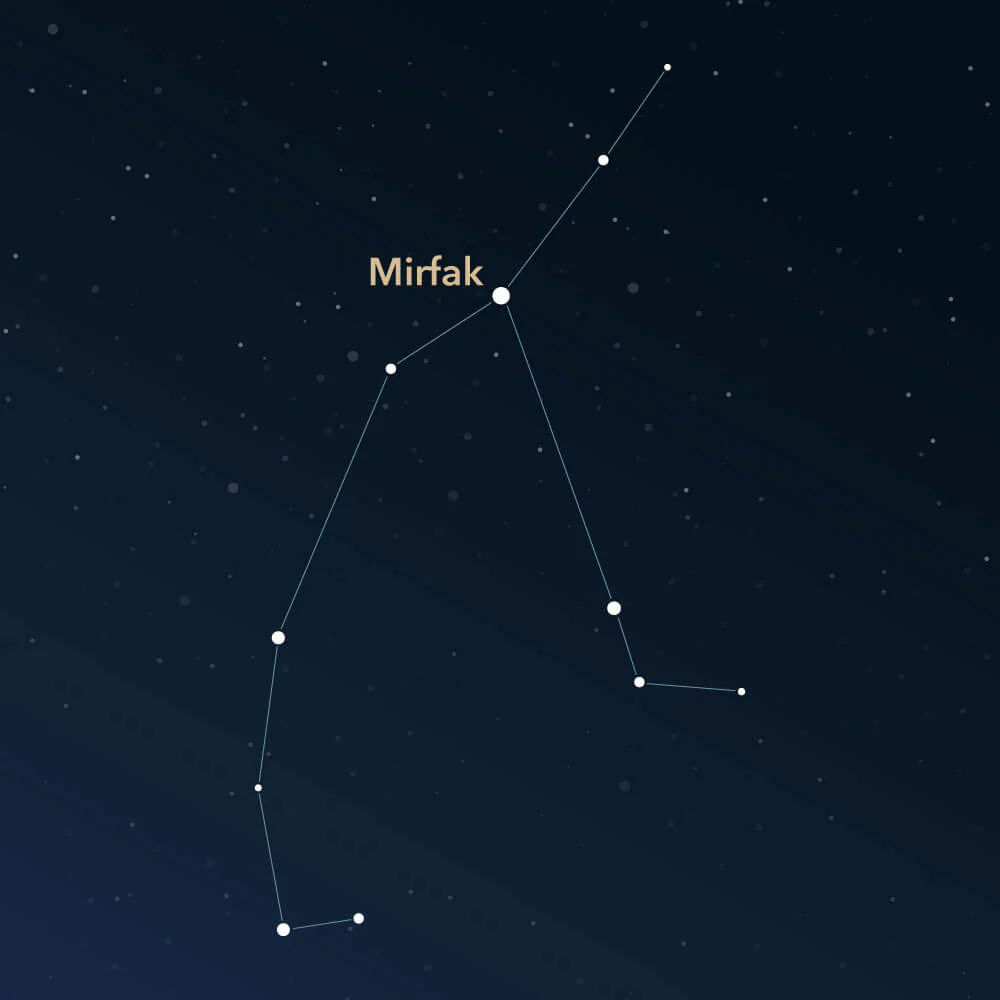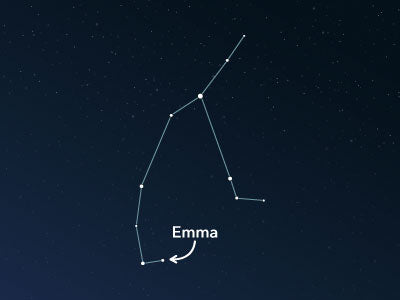The constellation Perseus
Características
- Nombre latino
- Perseus
- Hemisferio
- Hemisferio norte
- Visibilidad
- All year round
- Área
- 615 deg²
- Estrella más brillante
- Mirfak (HIP number 15863)
- Especialidades
- Open star cluster, planetary nebula, reflection nebula, emission nebula

Perseus is a prominent constellation in the northern sky. It is one of the 48 classical constellations described by the Roman-Greek astronomer Claudius Ptolemy in ancient times. Within its boundaries lie a variety of interesting deep-sky objects.
Hemisphere, visibility, and area
The constellation Perseus is located north of the celestial equator and can be observed from the entire northern hemisphere. South of the equator, it is only visible up to the 35th latitude. This corresponds roughly to regions such as the southernmost part of South Africa, Adelaide in Australia, or Buenos Aires in Argentina.
From latitudes such as Central Europe, Canada, or the northern area of the US, it is circumpolar, meaning it can be seen all year round. From southern locations, the months of September through March offer the best view of the constellation.
Perseus stretches across the night sky with approximately 615 square degrees, ranking it 24th in size compared to all other 88 constellations.
The visualization of the constellation depicts the hero Perseus holding the head of the deadly Medusa in his hand. Numerous stars are connected to each other to form roughly a Y-shape. The brightest star is Mirfak (Latin: α Persei, Alpha Persei). It represents part of Perseus' body. Mirfak is a yellow supergiant whose mass is approximately 11 times that of the sun. It also has an apparent brightness of around 1.8, making it one of the 50 brightest stars in the night sky.
Perseus borders seven other constellations. These include the two famous constellations, Cassiopeia and Andromeda. Aries and Taurus, which are particularly well-known in astrology, are also located near Perseus. In addition, the nearby constellations include Triangulum, Auriga, and Camelopardalis.
Specialties in the constellation
The band of the Milky Way runs through the area of Perseus, which is responsible for several open star clusters. In addition, there is a planetary nebula, a reflection nebula, and an emission nebula in the sky area.
The brightest open star cluster is named Melotte 20 or Collinder 39. It is located immediately around the main star Mirfak, which is also part of this group. The cluster has many bright stars, which is why the naked eye can recognize many individual stars. Although Melotte 20 has been known since ancient times, it has not yet been included in catalogs such as Messier or NGC. It was not until 1915 that the British astronomer Philibert Jacques Melotte cataloged the object.
The planetary nebula is cataloged as M76 (Messier 76) and NGC 650. It is also known by the names Little Dumbbell Nebula or Butterfly Nebula. It was discovered by the French astronomer Pierre Méchain in September 1780. M76 is difficult to observe with the naked eye because it is not particularly bright.

The reflection nebula NGC 1333 can only be seen in long-exposure astronomical photographs. The emission nebula NGC 1499 can only be perceived on particularly dark nights.
Mythology
According to Greek mythology, Perseus was the son of Zeus and Danae, the daughter of the king of Argos. The king banished his daughter and her newborn son to the island of Seriphos, as an oracle had predicted doom otherwise.
The king of the island took them in kindly but repeatedly tried to persuade the beautiful Danae to marry him. This displeased Perseus. However, the king always denied his intention to Perseus. In relief, Perseus promised his foster father a special gift - the head of Medusa. But the gaze of Medusa turned everyone she looked at into stone. So, the king assumed that Perseus would soon no longer stand in the way of the wedding.
However, Athena, who had transformed the once lovely Medusa into a monster, provided Perseus with the appropriate equipment, knowing that he was also a son of her beloved father, Zeus. Finally, Perseus managed to defeat Medusa and carry her head with him.
On his way home, Perseus passed by the virgin Andromeda, who had been chained to a rock by her father, Cepheus, as a sacrifice to the sea monster Cetus. He rescued her and asked for her hand in marriage. Cepheus allowed this, although he had promised her to his brother a long time ago. However, his brother did not want to give up on his promised bride and tried to chase Perseus away at the wedding ceremony.
Therefore, Perseus took the head of Medusa out of the opaque bag and turned his rival into stone. With his newly married wife, Perseus returned to Seriphos. He arrived just in time to prevent his mother's wedding to the local king. On the island, he founded a large family with Andromeda.
PublicadoLeer más artículos interesantes

An overview of all 88 constellations
Learn more about all 88 constellations and read interesting information about the mythology, visibility, and features.

Planetario App
¡Descubre el cielo nocturno con nuestra aplicación de planetario!
Disponible para iOS y Android.

Nombrar una estrella en una constelación
Name a star in a constellation and create something that lasts for eternity.